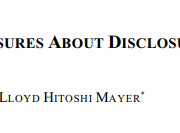The Center for Political Accountability (CPA) tells us that they are “the only group directly engaging companies to improve disclosure and oversight of their political spending.” To that end, they have released their annual Index of Corporate and Political Disclosure. The Index is an evaluation of the top 300 US companies on 24 variables indicating, purportedly, how well these companies perform at “disclosing” their spending on political speech.
But as CPA makes abundantly clear, the real purpose of their efforts is not disclosure, ipso facto. The disclosure of political donations is but a means of actively limiting the ability of companies to voice their opinions about the political issues of importance to them and their shareholders:
Companies are also requesting that their trade associations not use their dues and other payments to fund political activities. We are also seeing an increased level of corporate board oversight and voluntary disclosure when it comes to corporate political spending. These trends not only enhance disclosure; they also reflect a greater appreciation of the unnecessary harm and risks posed to a corporate brand that can come from focusing on political campaigns rather than on marketplace challenges. [Emphasis added]
In other words, companies need to be aware that activists will use political donations to publicly besmirch their brand, and that’s bad for the bottom line. Proof of this ulterior disclosure motive lies in the commonly cited example of Target. In 2010, Target donated to a Minnesota PAC that supported business friendly economic policies. But the pro-business candidate endorsed by this PAC, Minnesota Gubernatorial candidate Tom Emmer, also opposed same-sex marriage. Enter activist liberal groups who began an ill-fated boycott of Target (the annual sponsor of the Twin City Gay Pride Festival), for its supposedly anti-gay policies.
But CPA would tell us that the purpose of their Index is not to shame companies into silence on policy issues. They would argue that this is just about “transparency” and “public disclosure.” Unfortunately, their fluid methodology belies this claim. After all, if your end goal is “transparency,” then you need only to establish what that looks like and grade companies accordingly. But for the CPA Index, transparency is a moving target. In 2013, five of the 24 indicators were changed to require more information from companies. This year, six of the criteria were altered. The net effect of this change is that a company that received a first tier score in 2013 could drop to a third tier rating in 2014 having theoretically disclosed the exact same amount of information.
Why would that be? If your goal is “transparent” companies, what changed from 2013 to 2014 that warrants downgrading previously stellar disclosure into average to below average disclosure? We cannot know for sure. CPA says only that, the previous methodology, “[did] not offer enough specificity to be deemed transparent” and that, they desire “to reward transparency in a fair and balanced manner.”
But the upshot of this changing disclosure regime is clear; the CPA report again spells it out:
Data from the 2014 CPA-Zicklin Index reflect that many companies have placed restrictions on their political spending. This represents a major change since 2004, when few imposed such restrictions or had clear policies to that effect.
In other words, many companies have decided that speech advocating for their positions is not worth the risk and hassle.














